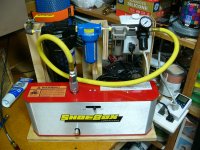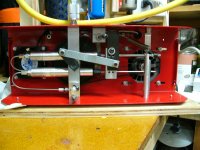Any pictures; I'm having a time visualizing the "first stage off loaded to a shop compressor."
Sure, but the pictures don't really tell the story - the math does (sorry, but I do love math

). The first picture is the basic set up, and you can see the shop air hose feeding into the top of the Shoebox after having passed through a manifold consisting of a big Silica desiccant drier, as smaller molecular sieve drier, a 0.2 micron particulate filter, then a regulator. The shop compressor is not in the picture - it is in my garage, a long way from the Shoebox compressor which is in my basement workshop, fed by a manifold system I put in my house. The second picture is the inside of the unit, with the air feeding in from the top down to a 0.25" first cylinder (second stage of compression, with the shop compressor being the first), then that flows into a 0.125" second cylinder (third and final stage of compression).
You have to remember that with compression, it is all about volume reduction - think compression ratio of your car's engine cylinders. The pressure itself varies in the process due to temperature (and combustion in your car's engine) and other factors like van der Whals forces (which we often ignore for simplicity, which holds pretty true up to about 250 bar or so), but the key is how much the volume changes. Since we are compressing our air from one bar to ~300 bar, we need to reduce the volume that air occupies by ~300 times. That is simply too much compression to do in one step, so it is done in multiple stages.
The way to think of approximating what has to happen in each stage is to take the root of the total ratio of compression, and since the Shoebox "system" consists of three total stages that would be the cube root; for 300 bar, the cube root results in a value of about 6.7 for each stage, and that is close to what we get from the shop compressor in the first stage - we can feed the Shoebox air at up to 125 psi, and I use 105 psi to both lighten the load and better balance with the shop compressor. 105 psi is 7.2 bar, so it slightly "overachieves" on what is needed for the first stage.
It is common for some to think that the compression happens in terms of dividing up the load equally in terms of pressure, but that is incorrect - it is done by volume reduction. With 3 stages and a ~6.7:1 ratio, the three stages would result in approximately the following pressures, after everything returns to ambient temperatures:
- First stage: ~6.7 bar, 97 psi
- Second stage: ~44.9 bar, 651 psi
- Third stage: ~300 bar, 4360 psi
While that "looks" very imbalanced in terms of the pressures that result, the percentage change in volume is approximately the same in all three stage (again, simplifying a bit by ignoring van der Whals forces, but these are accounted for in compressor design). Since the change in volume is the same in all three stages, the work done is the same in all three stages. So the temperature rise from the total work done is approximately the same for all three stages.
Since that first stage is completely separate from the Shoebox, the air charge can be fully cooled back to ambient before entering it. I make sure that is the case by running the shop compressor well in advance of my use (in fact it pretty much sits full all the time, ready for use of any kind at any point). That completely eliminates 1/3 of the heat of the compression. Add in that I blast those air lines inside my Shoebox to cool them high airflow with the cover off and it stays relatively cool. The other thing that helps keep things cool is that with three stages the air does not get as hot during each stage of compression, and there is opportunity to cool that charge down a bit between stages.
All the good dive compressors run with either three or four stages of compression, and that is done to help mange the loads and improve cooling. With four stages of compression, the compression ratio only has to be about 4:1 to get to 300 bar. Four stages of compression is simply awesome, especially when done with adequate air charge cooling between stages - but three stages works very well too when designed properly.
That leads to one of the key short comings in most small Chinese compressors today - they run just two stages (note that some of the GX pumps run four stages, which is a good thing). With two stages we have to take the square root of 300, resulting in compression ratios of over 17:1 - that is like a diesel engine feeding another diesel engine. That makes for high heat that is difficult to fully reject between stages, and high loads. So the design parameters call for a more robust overall design to handle the loads and heat, but the compressors are made as cheaply as possible - clearly not a recipe for a long service life . . .
As I said in my first post, I think it would be great for somebody to bring out a new compressor designed along the lines of the the Shoebox. It would serve us well.



